Volleyball Transition - Learn about Blocker to Hitter or Defense to Hitter Transition
Volleyball transition is one important skill that often gives troubles
for the players. It is challenging to transition i.e. from a
blocker to an offensive player after the team defense has managed to
dig the ball up.
Read tips for a better transition, or how to practice it?
Why Volleyball Transition Feels Difficult?
Limited TimeThe players have a very limited time to move from a blocker's position to a hitter – or from the blocker’s position to play defense and after the defense to swing the ball.
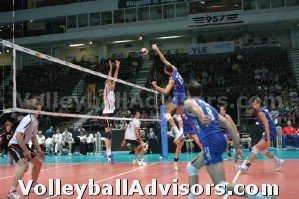
Footwork and Coordination
As in many other drills, it is needed to practice transitioning with the ball and in the game situation. However, it is very beneficial for the player to practice footwork and coordination of transition also without the ball. This is one of the few drills that really pays off when practicing it by your own or without the ball.
Transition
Footwork as Volleyball Conditioning Drills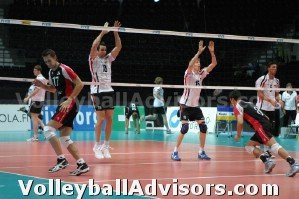
Volleyball transitioning drills without the ball can also serve as an
excellent volleyball conditioning drill.How to Do the Volleyball Transition?
Have a Standard Transition Routine - and Practice Repeating ItIt is a good idea for player to use same routine every time when backing off the block. It helps to learn the transition smoothly when repeating the same routine one after another.
Two Volleyball Transition Routines for the
Blocker: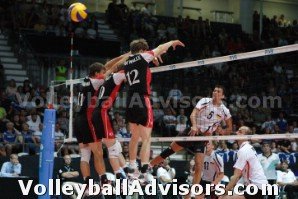
From Blocker
to HitterWhen starting to practice transition, test how many steps you need to take after your block to back up to the hitting position. (Most players get back to hitting position with three steps.)
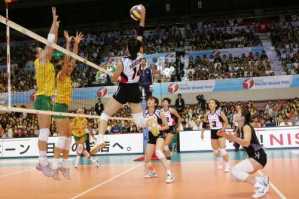
Blocker to Defense to Hitter
Also test how to move from a blocker to a defensive position - and after the defense to start a spike approach.
To practice those two transitions you just repeat the routines.
In the Match – the Transition Steps Are Not Always the Same
However, you still have to remember that in the match you may have to block inside or outside. For example if you are blocking inside, you have a longer distance back to the hitting position. It is also the fact that when performing a swing block, sometimes the blockers are “flying” and stopping somewhere outside the court. So in the match you also need to be ready to adjust your transition steps because you don’t always know the exact position you are landing to.
Players need to be exposed to those different situations in game-like practice drills, so they learn to adjust the steps without any problems.
The Standard Left-Side Volleyball Transition From the Blocker to Hitter:
Repeating the standard transition helps you to learn the technique when it is introduced.However, the players need to be exposed to transitions in the game-like drills because the transition could be slightly different in the match.
Volleyball Transition Example - Left Side Player
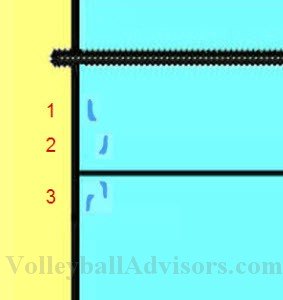
- After landing a player turns around (facing the
court) and takes a big step with the right foot. It depends on the
length of the step, but the foot could be placed somewhere around 4-6
feet off the net.
- The player takes another step and places left
foot on the ground. The foot could be around 7-9 feet off the net.
- On the third step, the player turns around to face the net again. The right foot lands around 11-12 feet off the net – being ready to start a hitting approach (right-left-right-left).
The right side players perform this as a mirrow image. Middles transitions are also very similar - on the left side as the left side spiker and on the right side as the right side spiker.
Two
Useful Techniques for Transition
You need to back up somewhere around 11-14 feet off the net to make a
full approach. You probably need to know at least two different
techniques: 1) If you are in a real hurry, you may have time only to back pedal a couple of quick steps, then perform a “half approach”.
2) If you have time for the full approach, like above, it is a better option.
Video Example of the Volleyball Transition
Here in the video, you see a pretty good example about the good transition. In the first transition, the player turns around a full turn and takes few fast transition steps. Second and third transitions are not perfect examples anymore – but at least you see how it should be done – and how it shouldn’t.Example of Volleyball Transition:
Look at the long rally and the first transition in this YouTube video. It is a pretty good example of good transition. It occurs between 0.06 and 0.11 in this video when an outside hitter on a red team transitions.
- The player you need to look at is on the left court side.
- At 0.06 the outside hitter on the left court
side makes the first swing. She hits the block and the ball
is reflected back to her own court side.
- She is in a hurry to approach again, therefore
she turns around, takes a few fast steps and she is way beyond the 10
foot line to approach again at 0.09 when the setter has the set. At
0.11 she makes the second swing.
- The first transition the player makes is a pretty good example.
- On the right hand side, everything works as a mirror image.
Backpedaling – Good or Bad?
The rally continues and the next transitions are not the best possible examples. The player backpedals and backs up slowly compared to the first transition.
In some situations “backpedaling” could be a reasonable choice. I.e. sometimes for the middle, it could be a reasonable option to “backpedal” and take one or two short quick steps back - when the player simply do not have enough time to make a complete transition. However, generally speaking the player should always turn around by opening up your body towards the court, just like the outside hitter in the video makes in the first transition. Or in the following video starting at 0.12 the middle blocker performs two transitions in a row by back pedaling.
Another Video about Volleyball Transitions
Pay attention to middle blockers transition at 0.12. He performs two transitions by backpadaling in a row.You also see an excellent example of the middle blocker who transitions by packpedaling on the first video between the 0.02 and 0.11.
Volleyball Quote to Remember

Transitioning Related Pages
Volleyball Blocking - How to Put the Ball Down?youtube.com - Middle Blocker Transitioning Training
Like this page:





